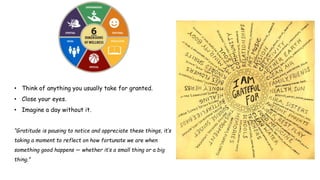
Electromagnetic Force 12 01 2023.pptx
- 1. • Think of anything you usually take for granted. • Close your eyes. • Imagine a day without it. “Gratitude is pausing to notice and appreciate these things, it’s taking a moment to reflect on how fortunate we are when something good happens — whether it’s a small thing or a big thing.”
- 2. To incorporate critical thinking and collaboration in analyzing the interaction between magnetic field and electric current Daily household items like electric motor, mixer grinder etc. works on this principle Collaboration, experimentation, critical thinking, simulation
- 3. PRE-ASSESSMENT 1. The magnetic field lines surrounding a bar magnet forms (a) Open loop (b) Closed loop 2. The magnetic field lines (a) May intersect each other (b) Never intersect each other (c) Sometimes intersect each other 3. A current carrying straight conductor produce magnetic field lines in the shape of (a) Sphere (b) Concentric circles (c) Parallel lines 4. The field lines inside a bar magnet (a) Is from south pole to north pole (b) Is from north pole to south pole (c) Doesn’t exist As magnetic field lines always form closed loop, a magnetic monopole doesn’t exist (a) True (b) False
- 4. W.A.L.T “To unravel the link between electricity and magnetism”
- 5. Two magnets can attract or repel. If current element can produce magnetic field, does it interact with other magnet? What are the practical applications of this?
- 6. KEY VOCABULARY Fleming’s Left Hand Rule: Stretch the thumb, forefinger and middle finger of your left hand such that they are mutually perpendicular. If the first finger points in the direction of magnetic field and the second finger in the direction of current, then the thumb will point in the direction of motion or the force acting on the conductor Alternating Current: Current which changes direction
- 7. You have the freedom to move through the lesson at your pace, for example, some of you may have studied the lesson beforehand or seen a video, you can quickly move on to progress check and activities. Some of you may not be able to solve the questions in progress check tab ( which is perfectly OK), you can go and refer to the resource again before you attempt the task again. All of you can collaborate with peers and/or learn independently. If you are unable understand any key content of the lesson, then you can always go back refer to the content and continue with the lesson at your pace. Please remember that with freedom comes a lot of responsibility. It is ultimately your journey and you have to make sure you complete the learning objective before going into the next lesson. Self-Reflection on your learning skills. Learning Menu -and how to use it-
- 8. My Learning Progress Chart (padlet.com)
- 9. To Do • List out the similarities and differences in the magnetic fields produced by a current carrying conductor and bar magnet WAGOLL Current carrying conductor Bar Magnet
- 10. WAGOLL I think the reason for this is because ….
- 11. To Do Illustrate Fleming’s Left Hand Rule using a neat labelled diagram and solve the following question: WAGOLL
- 12. WAGOLL
- 13. Plenary • Groups will formulate questions, based on the activities and knowledge acquired • These questions shall be answered by other groups • Complete the learning progress chart